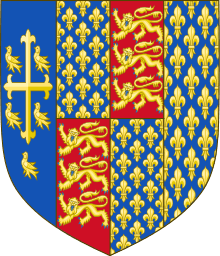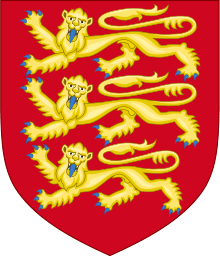Isabella of Valois
| Isabella of Valois | |
|---|---|
 | |
| Queen consort of England | |
| Tenure | 1 November 1396 – 30 September 1399 |
| Coronation | 8 January 1397 |
| Born |
9 November 1389 Paris, France |
| Died |
13 September 1409 (aged 19) Blois, Loir-et-Cher, France |
| Spouse |
Richard II of England Charles, Duke of Orléans |
| Issue | Joan of Valois, Duchess of Alençon |
| House | Valois |
| Father | Charles VI of France |
| Mother | Isabella of Bavaria |
Isabella of France (9 November 1389 – 13 September 1409) was Queen consort of England as the second spouse of King Richard II. Her parents were King Charles VI of France and Isabeau of Bavaria. She married the king at the age of seven and was widowed three years later. She later married Charles, Duke of Orléans, dying in childbirth at the age of nineteen.
Isabella's younger sister, Catherine, was Queen of England from 1420 until 1422, married to Henry V and mother of Henry VI. Catherine was also a grandmother of Henry VII.
Life

Isabella lived during a period of political tension between France and England known as the Hundred Years War, the situation made worse by the mental instability of her father.
On 31 October 1396, almost the age of seven, Isabella married the widower King Richard II of England in a move for peace with France.[1] The fact that she was a child was discussed during the negotiations, but Richard replied that each day would rectify that problem, that it was an advantage as he would then be able to shape her in accordance with his ideal, and that he was young enough to wait. Isabella herself told the English envoys, that she was happy to be Queen of England, because she had been told that this would make her a great lady. She is described as pretty, and reportedly practiced in order to be able to perform her role as queen. King Richard traveled to Paris to fetch her, where the wedding was celebrated with grand festivities at the French royal court, before they continued to the English enclave of Calais, where the formal wedding ceremony was performed on 31 October.
Queen of England
After the wedding, Queen Isabella followed Richard to England, where she was placed in Windsor Castle with her own court under the supervision of her appointed governess and chief lady-in-waiting Lady de Coucy (later replaced by Lady Mortimer). She was formally crowned Queen of England in Westminster in London the following year, 1397.
Although the union was political and an arranged marriage, Richard II and the child Isabella developed a mutually respectful relationship: Richard regularly visited her in Windsor, where he treated her with respect and entertained her and her ladies-in-waiting with humorous conversation, and Isabella reportedly enjoyed and looked forward to his visits.
By May 1399, the Queen had been moved to Portchester Castle for protection while Richard went on a military campaign in Ireland. During the following rebellion against Richard, Isabella was moved by the Duke of York first to Wallingford Castle and then to Leeds Castle. When on his return to England Richard II was imprisoned and died in custody, Queen Isabella was ordered by the new King Henry IV to move out of Windsor Castle and to settle in the Bishop of Salisbury's Thamesside palace at Sonning in formal house arrest.
Later life
In 1400, the deposed king was killed, and the French court requested that Isabella return to France. King Henry IV initially refused, deciding Queen Isabella should marry his son, the future Henry V of England, but she refused. Knowing her spouse was dead, she went into mourning, ignoring Henry IV's demands. In August 1401, he let her go back to France, but kept her dowry.[2]
In 1406, Henry IV repeated his suggestion that Isabella marry his son, but it was refused by the French court.
On 29 June 1406, Queen Isabella married her cousin Charles, Duke of Orléans.[3] She died in childbirth at the age of 19, leaving one daughter, Joan, who married John II of Alençon in 1424. Isabella was interred in Blois, in the abbey of St. Laumer, where her body was found in its entirety in 1624, curiously wrapped in bands of linen plated over with quicksilver. It was then transferred to the church of the Celestines in Paris.
In literature
In Shakespeare's play Richard II Richard's queen appears in two significant scenes at the time of his deposition, but she is portrayed as an adult. She is forced by the new king Henry IV to leave for France after the deposition.
Two well-regarded novels about Isabella's life appeared in the late 1950s. Hilda Lewis' The Gentle Falcon is about Isabella's marriage to Richard II, while Gladys Malvern's My Lady, My Love is about Isabella's later years after Richard's death and her return to France.[4]
Isabella appears in the historical novel In a Dark Wood Wandering (original Dutch title Het woud der verwachting) by Hella Haasse, which centers on the life of her second husband Charles, Duke of Orléans.
Arms
 |
|
Ancestry
| Ancestors of Isabella of Valois | ||||||||||||||||||||||||||||||||||||||||||||||||||||||||||||||||||||||||||||||||||||||||||||||||||||||||||||||||||||||||||||||||||||||||||||||||||||||||||||||||||||||||||||||||||||||||||||||||||||||||||||||||||||||||||||||||||||||||||||||||||||||||||||||||||||||||||||||||||||||||||||||||||||||||||||||||||||||||||||||||||||||||||||||||||||||||||||||||||||||||||||||||||||||||||||||||||||||||||||||||||||||||||||||||||||||||||||||||||||||||||||||||||||||||||||||||||||||||||||||||||||||||||||||||||||||||||||||||||||||||||||||||||||||||||||||||||||||||||||||||||||||||||||||||||||||||||||||||
|---|---|---|---|---|---|---|---|---|---|---|---|---|---|---|---|---|---|---|---|---|---|---|---|---|---|---|---|---|---|---|---|---|---|---|---|---|---|---|---|---|---|---|---|---|---|---|---|---|---|---|---|---|---|---|---|---|---|---|---|---|---|---|---|---|---|---|---|---|---|---|---|---|---|---|---|---|---|---|---|---|---|---|---|---|---|---|---|---|---|---|---|---|---|---|---|---|---|---|---|---|---|---|---|---|---|---|---|---|---|---|---|---|---|---|---|---|---|---|---|---|---|---|---|---|---|---|---|---|---|---|---|---|---|---|---|---|---|---|---|---|---|---|---|---|---|---|---|---|---|---|---|---|---|---|---|---|---|---|---|---|---|---|---|---|---|---|---|---|---|---|---|---|---|---|---|---|---|---|---|---|---|---|---|---|---|---|---|---|---|---|---|---|---|---|---|---|---|---|---|---|---|---|---|---|---|---|---|---|---|---|---|---|---|---|---|---|---|---|---|---|---|---|---|---|---|---|---|---|---|---|---|---|---|---|---|---|---|---|---|---|---|---|---|---|---|---|---|---|---|---|---|---|---|---|---|---|---|---|---|---|---|---|---|---|---|---|---|---|---|---|---|---|---|---|---|---|---|---|---|---|---|---|---|---|---|---|---|---|---|---|---|---|---|---|---|---|---|---|---|---|---|---|---|---|---|---|---|---|---|---|---|---|---|---|---|---|---|---|---|---|---|---|---|---|---|---|---|---|---|---|---|---|---|---|---|---|---|---|---|---|---|---|---|---|---|---|---|---|---|---|---|---|---|---|---|---|---|---|---|---|---|---|---|---|---|---|---|---|---|---|---|---|---|---|---|---|---|---|---|---|---|---|---|---|---|---|---|---|---|---|---|---|---|---|---|---|---|---|---|---|---|---|---|---|---|---|---|---|---|---|---|---|---|---|---|---|---|---|---|---|---|---|---|---|---|---|---|---|---|---|---|---|---|---|---|---|---|---|---|---|---|---|---|---|---|---|---|---|---|---|---|---|---|---|---|---|---|---|---|---|---|---|---|---|---|---|---|---|---|---|---|---|---|---|---|---|---|---|---|---|---|---|---|---|---|---|---|---|---|---|---|---|---|---|---|---|---|---|---|---|---|---|---|---|---|---|---|---|---|---|---|---|---|---|---|---|---|---|---|---|---|---|---|---|---|---|---|---|---|---|---|---|---|---|---|---|---|---|---|---|---|---|---|---|---|---|---|---|---|---|---|---|---|---|---|---|---|---|---|---|---|---|---|---|---|---|---|---|---|---|---|---|---|---|---|---|---|---|---|---|---|---|---|---|---|---|---|---|---|---|---|---|
| ||||||||||||||||||||||||||||||||||||||||||||||||||||||||||||||||||||||||||||||||||||||||||||||||||||||||||||||||||||||||||||||||||||||||||||||||||||||||||||||||||||||||||||||||||||||||||||||||||||||||||||||||||||||||||||||||||||||||||||||||||||||||||||||||||||||||||||||||||||||||||||||||||||||||||||||||||||||||||||||||||||||||||||||||||||||||||||||||||||||||||||||||||||||||||||||||||||||||||||||||||||||||||||||||||||||||||||||||||||||||||||||||||||||||||||||||||||||||||||||||||||||||||||||||||||||||||||||||||||||||||||||||||||||||||||||||||||||||||||||||||||||||||||||||||||||||||||||||
References
| Wikimedia Commons has media related to Isabella of Valois. |
- ↑ Hamilton 2010, p. 205.
- ↑ Stratford 2012, p. 14, 118.
- ↑ Knecht 2007, p. 51.
- ↑ https://www.kirkusreviews.com/book-reviews/hilda-lewis/gentle-falcon/
- ↑ Boutell 1863, p. 148.
Sources
- Boutell, Charles (1863), A Manual of Heraldry, Historical and Popular, London: Winsor & Newton
- Hamilton, Jeffrey (2010). The Plantagenets: History of a Dynasty. Continuum.
- Knecht, Robert (2007). The Valois: Kings of France 1328-1589. Hambledon Continuum.
- Stratford, Jenny (2012). Richard II and the English Royal Treasure. The Boydell Press.
| English royalty | ||
|---|---|---|
| Vacant Title last held by Anne of Bohemia |
Queen consort of England Lady of Ireland 31 October 1396 – 30 September 1399 |
Vacant Title next held by Joanna of Navarre |
